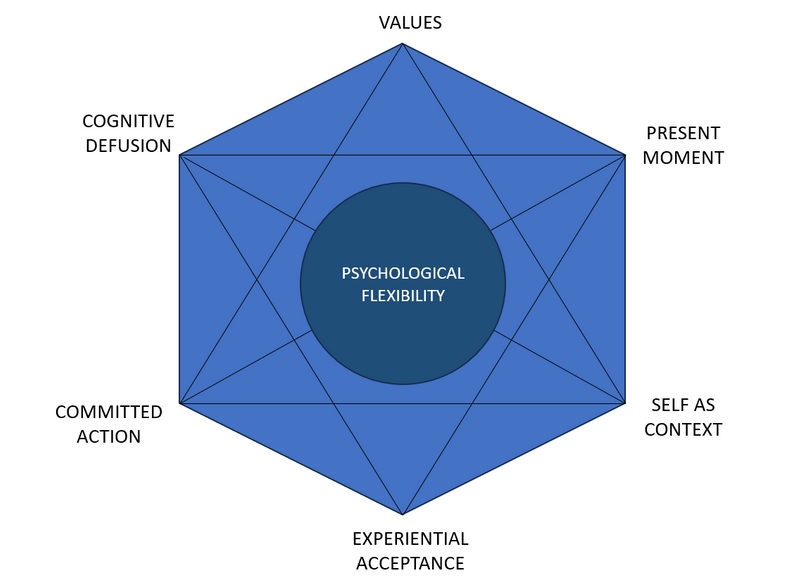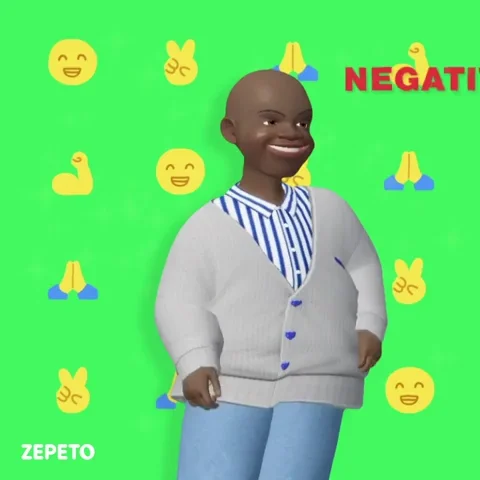If you've experienced any of the following, you're not alone:
Overwhelming anxiety of worry
Feelings of sadness or depression
Stress that feels unmanageable
Lack of vision for your future

We live in challenging times of rapid change that can feel unmanageable.
The good news is there are research-based tools to help you increase your psychological flexibility and increase your sense of well-being in the midst of challenging circumstances.
What is psychological flexibility and why is it important?
If you have psychological flexibility, you can adapt to changing situations by making decisions that are consistent with your values and goals. This can help you manage stress and overcome obstacles.
Psychological flexibility is a core concept of Acceptance and Commitment Therapy (ACT), which was developed by psychologist and researcher Steven C. Hayes.
The strategies you will learn here come from the 6 core processes of the hexaflex model of ACT,shown below:
 Image courtesy of Steven C. Hayes
Image courtesy of Steven C. Hayes

Hexaflex model of ACT — Visual Created by Author
To hear an audio description of the diagram above, press play on the audio player below:
Strategy #1: Clarify your values
Trying to make decisions without knowing what your true values are can be like trying to navigate without a map or a compass. You might get somewhere, but you're more likely to get lost and take unwanted detours.

By taking inventory of your values, you will have a "true north" to guide and empower you.
Valuesare what matter most to you in life, such as family, compassion, friendship, or honesty. Values are sometimes confused with goals, which are desired results you are trying to achieve. Your goals should align with your values.
Here is an example of the difference:

Value: Love of family

Goal: Take a vacation to spend time with family members
Take some time to explore your values. You can use exercises such as:
Values Card Sort: Cut out the value cards and sort them into three categories: very important to me, important to me, and not important to me.
Values Worksheets: Explore this collection of values clarification worksheets and quizzes from developgoodhabits.com.
Those who have a ‘why’ to live, can bear with almost any ‘how’.
— Viktor Frankl, author, Man's Search for Meaning
Quiz
Which one of these is a value?
Strategy #2: Focus on the present moment
Focusing on the present moment is a strategy based on the premise that you can only control your current behavior. You can’t control your past, your future, or even how you think or feel.

Dwelling on past mistakes or worrying about the future can lead to anxiety.
Though you can learn from your past and have hope for your future despite uncertainty, letting anxiety overwhelm you can be your default mode of thinking without present moment awareness.

Mindfulness exercises can help you shift from negative thinking patterns and motions to focusing on what you can control.
Here is a simple one to try, using the Right Here, Right Now worksheet:
Sit in a quiet place, and notice the sensation of your body in the chair.
Pay attention to your breathing, noticing the rise and fall of your chest.
Notice the sensation of your feet on the floor.
Notice any tension in body or fact, and let it go.
Now expand your awareness to the sensations around you: what do you see, hear, smell, taste, and feel?
If a thought pops up, take note of it, and refocus your attention on your breath.
Try to continue this exercise for a set period of minutes, staying in the present moment.
Strategy #3: Observe your thoughts, feelings, and actions (Self as Context)
You're more than your past experiences and thoughts.
Once you start practicing present moment awareness, you can get better at noticing your thoughts and feelings, and identify labels and self-imposed judgments you have been living under. You can separate between your conceptualized self and your observing self.

Let’s say you've labeled yourself as a “failure” based on past experience.
This is your conceptualized self, or what you’ve come to believe about yourself, but it is not an absolute truth rooted in anything outside of your own thoughts.
You may have developed these kinds of thoughts as a result of comparing yourself to others, which actually keeps you from developing healthy connections.
When you're able to detach from your thoughts and feelings as the “observing self,” it’s possible to learn how to reframe negative thoughts.
Remind yourself that this is a thought and not a truth. Thoughts and feelings come at us constantly, changing like the weather outside we can’t control.
Separating yourself as an observer can help give you distance from negative patterns and help you see things from a neutral perspective.
Strategy #4: Let yourself feel difficult emotions (Experiential Acceptance)
Practicing experiential acceptance means staying open to experiencing feelings, both good and bad.
Emotions are natural and informative. If you pay attention to them, even the private ones you don’t want anyone else to know about, you can better understand your needs and motivations.

The opposite of experiential acceptance is experiential avoidance. If you avoid your feelings, they won’t go away, but they will have more control over you. You can’t manage your emotions in a healthy way unless you're tuned in to them.

Everyone wastes energy obsessing over or trying to change feelings they wish would go away. But with acceptance, you can change your relationship with the emotions you can't control, and become free to control your behavior in alignment with your values.
Strategy #5: Separate yourself from your thoughts (Cognitive Defusion)
Just as you can start to recognize and accept your emotions, you can also learn to notice the process of your thoughts. Thoughts are not facts. You interpret reality in your mind based on what you know and have experienced, but it is often distorted and biased.

It's possible to welcome your thoughts and make room for them without immediately reacting to them. Imagine them as unexpected guests who have come to hang out.
You can listen to them, accept them, and understand them, but also question them and examine the evidence.

The way you interpret your thoughts and feelings translates into how you view yourself.
Cognitive defusion is the practice of separating negative thoughts or labels you‘ve associated with yourself from your actions and putting some space between what you think and how you react.
Quiz
Mike just found out he didn't get a job opportunity he'd been interviewing for and immediately thinks "I'm such a loser." What are some examples of cognitive defusion he could use to counteract this thought?
Strategy #6: Take actions that align with your values (Committed Action)
Finally, committed action means taking steps towards valued goals even while experiencing uncomfortable feelings and thoughts.

When faced with a decision, ask yourself: "What action can I take right now to honor my values instead of reacting to the thought or feeling?"

As these small steps build on each other so that you feel that you are being true to your values, you'll find the freedom to live your best life, even during difficult circumstances.
Emotional discomfort is a part of the human experience. However, by removing the added suffering of struggling against or avoiding your thoughts and emotions, you can develop the psychological flexibility to become resilient, stronger, and better able to persevere.
Take Action
Following these strategies won't guarantee that you'll meet all your personal goals. However, using tools to manage your thoughts and emotions so that you can control your response and act in alignment with your values will give you a permanent edge.

Your feedback matters to us.
This Byte helped me better understand the topic.

